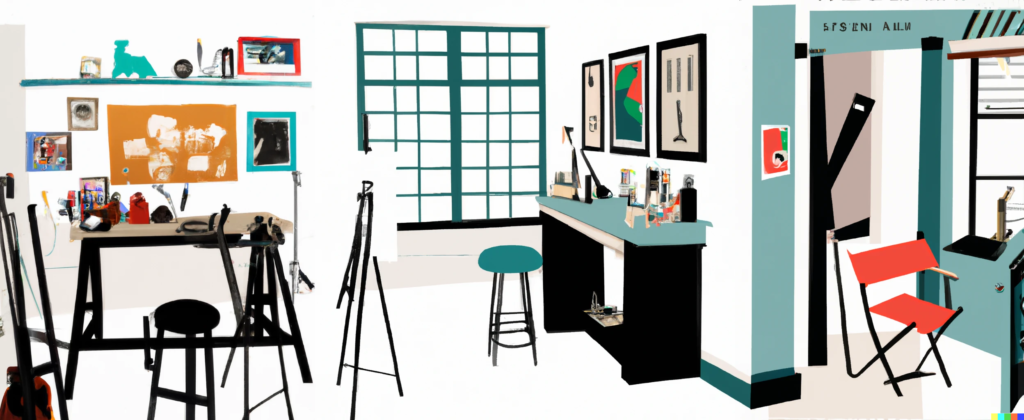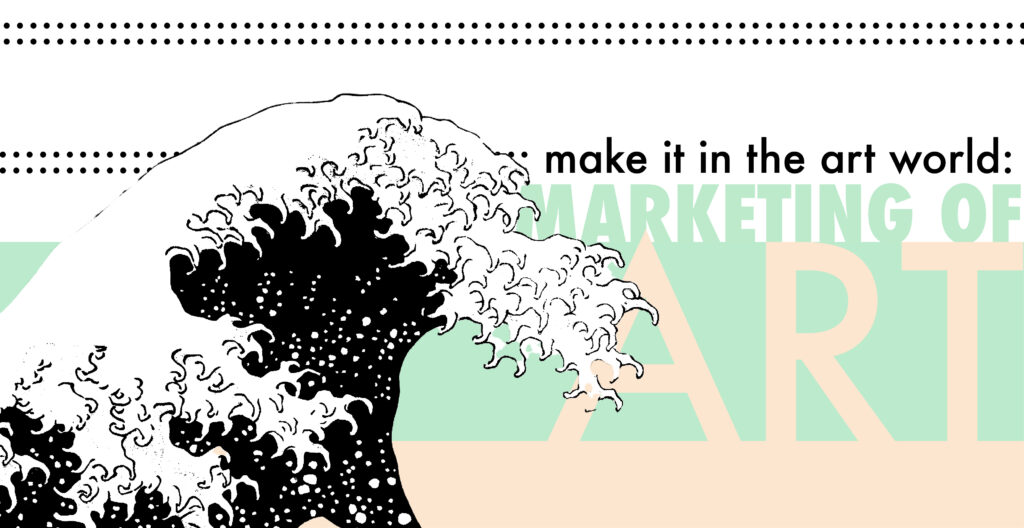
Art Marketing: How to make it in the Art World
The art world is a competitive landscape, and success hinges on more than just talent. For artists seeking recognition, mastering the art of promotion is just as crucial as refining their creative skills in order to make it in the art world. In this article, we’ll explore key art marketing strategies that can make or break an artist’s career.
A strong online presence is vital in today’s digital age. Building an artist website or showcasing work in an online art gallery makes art accessible to potential buyers and collectors worldwide. Social media for artists is another powerful tool, enabling them to engage with their audience, share insights into their creative process, and create brand awareness.
Art collaborations and art sponsorships are also effective marketing tools. Partnering with brands, influencers, or other artists can broaden an artist’s reach and open up new opportunities. Additionally, pursuing art grants, offering art workshops, and seeking art education can help artists develop their skills and reputation.

The World of Art Commerce: concepts for art marketing
The art items market is a diverse and dynamic space, encompassing a vast array of mediums, styles, and price points. From paintings and sculptures to limited edition prints and photography, the art marketing scene offers a wealth of opportunities for artists, collectors, and investors alike. In this article, we’ll explore the key aspects of the art items market and discuss the factors shaping its future.
Market Segments
The art items market is broadly segmented into four categories: fine art, decorative art, antiques, and collectibles. Fine art includes paintings, drawings, sculptures, and photography, while decorative art comprises items like ceramics, glass, textiles, and furniture. Antiques refer to objects with significant historical value, typically over 100 years old, while collectibles encompass a wide range of items, such as stamps, coins, and memorabilia.
Market Dynamics
The art items market is influenced by various factors, including economic conditions, global events, and changing consumer preferences. The market often experiences fluctuations, with demand for certain genres or artists rising and falling over time. Additionally, the market has witnessed a shift towards digital channels, with online art sales and auctions becoming increasingly popular.
Online Art Market
The rise of the internet has transformed the art items market, providing artists with new avenues to showcase their work and connect with collectors. Online art platforms and galleries, such as Artsy and Artfinder, have democratized the market, making it more accessible to emerging players wanting to make it in the art world and buyers who may not have the means or connections to participate in traditional art events. Furthermore, online auctions and social media platforms have played a significant role in expanding the market’s reach.
Art Fairs and Auctions
Art fairs and auctions remain essential components of the art items market, allowing artists to exhibit their work to a discerning audience and collectors to acquire unique pieces. Prestigious events like Art Basel, Frieze Art Fair, and TEFAF provide a platform for artists to gain exposure, while renowned auction houses such as Christie’s, Sotheby’s, and Phillips drive the high-end segment of the market.
Investment and Collecting
The art items market attracts a diverse range of participants, from passionate collectors to investors seeking alternative assets. While some view art as a form of cultural expression or personal enjoyment, others approach it as a long-term investment. The market’s potential for high returns and the allure of owning rare or valuable pieces continue to draw collectors and investors worldwide.

Trends in the Art Market
The art market is constantly evolving, with new trends emerging as artists, collectors, and galleries adapt to changes in technology, society, and the economy. Here are some key trends in the art market to be aware of:
Online sales and virtual galleries: The COVID-19 pandemic accelerated the shift towards online sales and virtual galleries. Many art fairs, galleries, and auction houses have adopted digital platforms to showcase and sell artworks. This trend is expected to continue as technology improves and buyers become more comfortable with purchasing art online.
NFTs and digital art: Non-fungible tokens (NFTs) have exploded in popularity, allowing artists to create, market, and trade digital art on blockchain platforms. This new form of art ownership and trading has attracted a new generation of collectors and created new opportunities for artists. Whether AI art generated by artificial intelligence can be considered art in its narrow definition is and will remain open for debate.
Socially conscious art: Art that addresses social, political, and environmental issues has gained traction in recent years. Collectors and galleries are increasingly interested in artworks that reflect the current zeitgeist, promote awareness, and inspire change. Leveraging this trend could be a good way of making it in the art market as a new producer.
Focus on diversity and inclusion: The art market is making efforts to become more inclusive and diverse, with galleries, museums, and collectors showcasing and acquiring works by artists from underrepresented backgrounds. This shift towards greater representation will likely continue to shape the art market in the coming years.
Emerging markets: Art markets in countries such as China, India, and Brazil have been growing rapidly, fueled by a growing middle class with disposable income and an interest in art collecting. As these markets continue to develop, they will play an increasingly significant role in the global art market.
Art as an investment: More and more collectors are viewing art as an alternative investment, particularly during times of economic uncertainty. This trend has led to increased demand for artworks by established artists with proven track records and the potential for future value appreciation. Art can be easily stored and moved which makes it an attractive value-storing option.
Sustainable art practices: There is a growing interest in sustainable art practices, including the use of eco-friendly materials and techniques, as well as the promotion of recycling and upcycling in art creation. This trend is likely to gain momentum as environmental concerns become increasingly important to artists and collectors alike.
Collaboration between art and technology: in art marketing, the intersection of art and technology has given rise to new creative possibilities, with artists incorporating cutting-edge technologies such as virtual reality, artificial intelligence, and 3D printing into their work. These collaborations are expected to continue to push the boundaries of artistic expression.
These trends demonstrate the dynamic nature of the art marketing and the potential for new opportunities and challenges in the years to come.

Successful Art Marketing Strategies: Unlocking the Potential of Your Artistic Endeavors
The art world is a competitive landscape where talent alone is not enough to guarantee success. To make a lasting impression and build a sustainable career, artists must also master the art of marketing. In order to make it in the art world you will have to stay on top of this successful art marketing strategies that can help artists increase their visibility, build their brand, and ultimately, sell their work.
Create a strong online presence
In today’s digital age, an online presence is crucial for artists. A professional website showcasing your portfolio, artist statement, and biography helps establish credibility and allows potential buyers to explore your work. Social media platforms like Instagram, Facebook, and Twitter can help you connect with your audience, share your creative process, and promote upcoming events. Regularly updating your website and social media accounts with new work, behind-the-scenes content, and engaging stories will keep your audience interested and coming back for more.
Network in the art community
Building relationships within the art community can open doors to new opportunities and collaborations. Attend gallery openings, art fairs, and workshops to meet fellow artists, curators, and collectors. Join local art organizations and participate in group exhibitions to gain exposure and create connections. Networking not only helps you gain visibility but also allows you to learn from other artists and industry professionals.
Develop a unique brand
A strong brand identity differentiates you from other artists while art marketing in the different channels and makes your work memorable. Consider your artistic style, values, and story when developing your brand. Use consistent visual elements, such as a logo, color palette, and typography, across your website, social media, and promotional materials to create a cohesive brand image. A compelling artist statement and biography that convey your unique perspective and artistic vision can also help you stand out in a crowded market.
Leverage email marketing
Email marketing is an effective way to communicate with your audience directly, announce new works, and promote upcoming events. Build an email list by encouraging website visitors to subscribe and collecting email addresses at art shows and networking events. Use an email marketing platform to create visually appealing newsletters that showcase your work, share your creative process, and keep your audience informed about your artistic journey.
Collaborate with other artists and businesses
Collaborating with other artists or partnering with local businesses can help you reach new audiences and increase your visibility. Consider co-creating artwork, hosting joint exhibitions, or partnering with local businesses to display your work. These collaborations can lead to new opportunities, such as referrals, commissions, and cross-promotion with your partners.
Participate in art fairs and festivals
Art fairs and festivals provide an excellent opportunity to showcase your work to a large audience, gain exposure, and make sales. Research local and international art fairs that align with your work and target audience, and submit applications well in advance. Prepare high-quality promotional materials, such as business cards, postcards, and catalogs, to share with potential buyers and industry professionals.
Offer a range of pricing options
Offering a range of pricing options can make your work accessible to a broader audience and increase the likelihood of sales. In addition to original artwork, consider selling prints, merchandise, or smaller works at lower price points. Providing flexible payment options, such as installment plans, can also make it easier for buyers to invest in your art.
Successful art marketing requires a combination of creativity, persistence, and strategic planning. By implementing these strategies, artists can build their brand, engage their audience, and ultimately, find success in the competitive art world – At Ikono, we are happy to support your art project with dedicated ad-hoc consulting that will help you make it in the art world.


